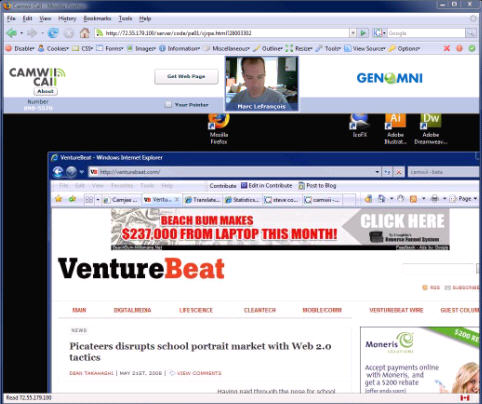 While some used the Web 2.0 conference in San Fransisco a few weeks back to reiterate bubble forecasts, some entrepreneurs were pitching their companies with frenzied fervor.
While some used the Web 2.0 conference in San Fransisco a few weeks back to reiterate bubble forecasts, some entrepreneurs were pitching their companies with frenzied fervor.
Marc LeFrancois was one of them.
The Canada-based entrepreneur crisscrossed the continent to present his company’s flagship product, Camwii, a desktop-sharing collaboration and video conferencing tool.
LeFrancois, CEO of Genomni, demoed screen sharing software with a new twist: it’s “out of the box” and doesn’t require installation for guest users.
I have to admit, when I first heard of Camwii, I wasn’t gearing myself up to be impressed, but when I saw the video, I was quite surprised at how unique the software is.
The video demonstrates a use case consisting of Marc, a real-estate agent in Canada, showing property listings to Jennifer, a San-Fransisco based customer. While on the phone, Marc hypothetically directs Jennifer to CamWii’s website, where she promptly enters his phone number and sees Marc’s screen without downloading any software.
Camwii has a one-click “share screen” button that is the centerpiece of an easy-to-use interface, which the company is banking on.
Marc proceeds to show Jennifer multiple photos of real-estate listings. The WYSIWYG (what you see is what you get) interface hopes to eliminate the question “can you see this, can you see that?”
In fact, I was so impressed by Camwii, I recommend it for any entrepreneurs — especially those who demo their products to VentureBeat, as it’s much simpler to use than WebEx.
For now the software is available for hosting a screen share on Windows XP and Vista, and while users can join from Mac-OSX, they can not host their own conference. LeFrancois says Skype integration will come soon and adds that he’s also been approached by VoIP, ISP and software providers for licensing opportunities, which will be offered in a few months.
LeFrancois says Camwii is different from competing products such as Webex in its core: it’s coded in assembly, a machine language, while its front end is built with Adobe’s Flex/Flash, which he says gives the app more speed and stability than its competitors, although he didn’t provide hard data.
Because the software runs on Flash, there’s no download needed for a customer who wants in on a conference, which isn’t the case for Webex, Citrix and its kin.
The company, however, doesn’t want to go toe to toe with the screen sharing heavyweights, choosing rather to initially sell its products to sales call centers, real estate agencies, and customer support companies, on a revenue sharing basis.
The first product is aptly named “CAMWII Sales Assitant,” while the second, CAMWII e-learning, is targeted at what LeFrancois says was a $50 billion market in 2007: distance learning, which has no clear market leader, he says. The company has been in talks with Stanford University and the University of California, Los Angeles, and while LeFrancois says the discussions were very positive, Genomni has not closed any deals with universities or other learning institutions yet.
The company was founded in July 2007 and launched privately in March 2008 before opening its doors to the public just a few days ago on May 10.
While the company has not yet raised funding, LeFrancois says that after the Web 2.0 conference, he has fielded several inquiries from various Venture Capital firms.
David Adewumi, a contributing writer with VentureBeat, is the founder & CEO of http://heekya.com a social storytelling platform billed “The Wikipedia of Stories.”
VentureBeat's mission is to be a digital town square for technical decision-makers to gain knowledge about transformative enterprise technology and transact. Learn More
